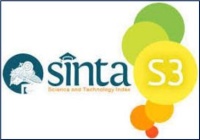Identification of Potential Isolate Phosphate Solubilizing Bacteria Used 16S rRNA Gene
Abstract
Keywords
Full Text:
Full PaperReferences
Abdelaziz, T., and Assia, M. (2020). Comparison of IncL/M Plasmids Using the Neighbor-Joining Method on Basis repA and excA Genes. Current Research in Bioinformatics, 8(1), 14-17.
Akihary, C.V., dan Kolondam, B.J. (2020). Pemanfaatan Gen 16s rRNA sebagai Perangkat Identifikasi Bakteri untuk Penelitian-penelitian di Indonesia. PHARMACON: Jurnal Ilmiah Farmasi, 9(1), 16-22.
Babalola, O.O., and Glick, B.R. (2012). Indigenous African Agriculture and Plant Associated Microbes: Current Practice and Future Transgenic Prospects. Scientific Research and Essays, 7(28), 2431-2439.
Don, N.T., and Diep, C.N. (2014). Isolation, Characterization and Identification of Phosphate- and Potassium- Solubilizing Bacteria from Weathered Materials of Granite Rock Mountain, That Son, an Giang Province, Vietnam. American Journal of Life Sciences, 2(5), 282-291.
Durairaj, K., Velmurugan, P., Park, J.H., Chang, W.S., Park, Y.J., Senthilkumar, P., Choi, K.M., Lee, J.H., and Oh, B.T. (2017). Potential for Plant Biocontrol Activity of Isolated Pseudomonas aeruginosa and Bacillus stratosphericus Strains Against Bacterial Pathogens Acting Through Both Induced Plant Resistance and Direct Antagonism. FEMS Microbiology Letters, 364(23), 1-10.
Gangwar, M., Saini, P., Nikhanj, P., and Kaur, S. (2017). Plant Growth-Promoting Microbes (PGPM) as Potential Microbial Bio-Agents for Eco-Friendly Agriculture. Advances in Soil Microbiology: Recent Trends and Future Prospects, 9(3), 37-55.
Gondal, A.H., Farooq, Q., Hussain, I., dan Toor, M.D. (2021). Role of Microbes in Plant Growth and Food Preservation. Agrinula: Jurnal Agroteknologi dan Perkebunan, 4(2), 106-121.
Hassler, H.B., Probert, B., Moore, C., Lawson, E., Jackson, R.W., Russell, B.T., and Richards, V.P. (2022). Phylogenies of the 16s rRNA Gene and Its Hypervariable Regions Lack Concordance with Core Genome Phylogenies. Microbiome, 10(1), 104-113.
Heuck, C., Weig, A., and Spohn, M. (2015). Soil Microbial Biomass C: N: P Stoichiometry and Microbial Use of Organic Phosphorus. Soil Biology and Biochemistry, 85(1), 119-129.
Inderbitzin, P., Robbertse, B., and Schoch, C.L. (2020). Species Identification in Plant-Associated Prokaryotes and Fungi Using DNA. Phytobiomes Journal, 4(2), 103-114.
Istina, I.N., Widiastuti, H., Joy, B., and Antralina, M. (2015). Phosphate-Solubilizing Microbe from Saprists Peat Soil and Their Potency to Enhance Oil Palm Growth and P Uptake. Procedia Food Science, 3(1), 426-435.
Kalayu, G. (2019). Phosphate Solubilizing Microorganisms: Promising Approach as Biofertilizers. International Journal of Agronomy, 1-7.
Khan, M.S., Zaidi, A., and Ahmad, E. (2014). Mechanism of Phosphate Solubilization and Physiological Functions of Phosphate-Solubilizing Microorganisms. In Phosphate Solubilizing Microorganisms: Principles and Application of Microphos Technology (pp. 31-62). Switzerland, Switzerland: Springer International Publishing.
Kumar, S., Diksha, Sindhu, S.S., and Kumar, R. (2022). Biofertilizers: An Ecofriendly Technology for Nutrient Recycling and Environmental Sustainability. Current Research in Microbial Sciences, 3(1), 1-26.
Kumar, V., Kumar, M., Sharma, S., and Ajit, V. (2016). Interaction Among Rhizospheric Microbes, Soil, and Plant Roots: Influence on Micronutrient Uptake and Bioavailability. Switzerland: Springer International Publishing.
Linu, M.S., Asok, A.K., Thampi, M., Sreekumar, J., and Jisha, M.S. (2019). Plant Growth Promoting Traits of Indigenous Phosphate Solubilizing Pseudomonas aeruginosa Isolates from Chilli (Capsicum annuum L.) Rhizosphere. Communications in Soil Science and Plant Analysis, 50(4), 444-457.
Mishra, D., Rajvir, S., Mishra, U., and Kumar, S. (2013). Role of Bio-Fertilizer in Organic Agriculture: A Review. Research Journal of Recent, 2(ISC-2012), 39-41.
Monica, I.F., Saparrat, M.C.N., Godeas, A.M., and Scervino, J.M. (2015). The Co-Existence between DSE and AMF Symbionts Affects Plant P Pools Through P Mineralization and Solubilization Processes. Fungal Ecology, 17(1), 10-17.
Osińska-Jaroszuk, M., Jarosz-Wilkołazka, A., Jaroszuk-Ściseł, J., Szałapata, K., Nowak, A., Jaszek, M., Ozimek, E., and Majewska, M. (2015). Extracellular Polysaccharides from Ascomycota and Basidiomycota: Production Conditions, Biochemical Characteristics, and Biological Properties. Journal of Microbiology and Biotechnology, 31(12), 1823-1844.
Raj, D.P., Linda, R., and Babyson, R.S. (2014). Molecular Characterization of Phosphate Solubilizing Bacteria (PSB) and Plant Growth Promoting Rhizobacteria (PGPR) from Pristine Soils. International Journal of Innovative Sience, Enginering and Technology, 1(7), 317-324.
Sembiring, A., dan Sumanto, N.L. (2019). Isolation of Antifungi Bacteria from Banana Rhizosphere to Inhibit Fusarium oxysporum f.sp cubense (FOC) Growth. JBIO: Jurnal Biosains (the Journal of Biosciences), 5(3), 105-110.
Sharma, S.B., Sayyed, R.Z., Trivedi, M.H., and Gobi, T.A. (2013). Phosphate Solubilizing Microbes: Sustainable Approach for Managing Phosphorus Deficiency in Agricultural Soils. Springer Plus, 2(1), 1-14.
Suresh, P., Rekha, M., Gomathinayagam, S., Ramamoorthy, V., Sharma, M.P., Sakthivel, P., Sekar, K., Valan-Arasu, M., and Shanmugaiah, V. (2022). Characterization and Assessment of 2, 4-Diacetylphloroglucinol (DAPG)-Producing Pseudomonas fluorescens VSMKU3054 for the Management of Tomato Bacterial Wilt Caused by Ralstonia solanacearum. Microorganisms, 10(8), 1508-1517.
Suyal, D.C., Shukla, A., and Goel, R. (2014). Growth Promotory Potential of the Cold Adapted Diazotroph Pseudomonas Migulae S10724 Against Native Green Gram (Vigna radiata (L.) Wilczek). 3 Biotech, 4(6), 665-668.
Tomer, S., Suyal, D., and Goel, R. (2016). Biofertilizers: A Timely Approach for Sustainable Agriculture. In Choudhary DK et al. (Ed.), Plant-Microbe Interaction: An Approach to Sustainable Agriculture (pp. 375-395). Switzerland, Switzerland: Springer Nature.
DOI: https://doi.org/10.33394/bioscientist.v10i2.6218
Refbacks
- There are currently no refbacks.

This work is licensed under a Creative Commons Attribution-ShareAlike 4.0 International License.

Bioscientist : Jurnal Ilmiah Biologi is licensed under a Creative Commons Attribution-ShareAlike 4.0 International License
Editorial Address: Pemuda Street No. 59A, Catur Building Floor I, Mataram City, West Nusa Tenggara Province, Indonesia











